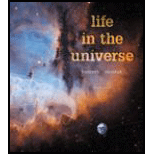
Briefly explain how the larger jovian moons tend to differ in general from the smaller ones. How does the formation process of the moons explain these differences?
The difference between large Jovian moons from the smaller ones.
Answer to Problem 1RQ
The large Jovian moon is different from the small Jovian moon in appearance and the properties by which they orbit around the planet.
Explanation of Solution
The large Jovian moon is different from the small Jovian moon in appearance and the properties by which they orbit around the planet.
Most of the small moon such as (Calypso, Pandora, Phoebe, Janus)are irregular in shape and sometimes they resemble to potatoes, peanuts and other snacks while mostly all the large moons are spherical in shape such as (Titan, Ganymede, Io , Europa).
The small objects have very less gravity, and it is very weak that it cannot force the rigid material by which the moons are made of to form the sphere.
Many small moons are fragments of large moons that are broken apart so they have similar characteristic as the larger moon.
The two largest moons, Titan of Saturn and Ganymede of Jupiter are bigger than Mercury. Almost all of the moderate to large size moons orbit around the planet in the same way as planets orbit around the sun.
Many of the small moons also have orbits that are extremely elliptical to their host planets and some moons have retrograde motion too.
Conclusion:
Thus, the large Jovian moon is different from the small Jovian moon in appearance and the properties by which they orbit around the planet.
Want to see more full solutions like this?
Chapter 9 Solutions
Life in the Universe Plus Mastering Astronomy with Pearson eText -- Access Card Package (4th Edition) (Bennett Science & Math Titles)
Additional Science Textbook Solutions
Essential University Physics (3rd Edition)
University Physics Volume 2
The Cosmic Perspective (8th Edition)
University Physics Volume 1
Essential University Physics: Volume 2 (3rd Edition)
Conceptual Physical Science (6th Edition)
- We have a lot of good images of the large moons of Jupiter and Saturn from the Galileo and Cassini spacecraft missions (check out NASA’s Planetary Photojournal site, at http://photojournal.jpl.nasa.gov, to see the variety). Now that the New Horizons mission has gone to Pluto, why don’t we have as many good images of all sides of Pluto and Charon?arrow_forwardCompare the interior cutaway sketches of the four Jovian planets in their Celestial Profiles. What interior layer(s) is (are) shown in Jupiter and Saturn but not in Uranus and Neptune, and vice versa?arrow_forwardDescribe the different processes that lead to substantial internal heat sources for Jupiter and Saturn. Since these two objects generate much of their energy internally, should they be called stars instead of planets? Justify your answer.arrow_forward
- Describe the composition of Saturn from its center outward. What causes these different internal layers?arrow_forwardDescribe the location of the equinoxes and solstices in the Uranian sky. What are the seasons like on Uranus?arrow_forwardWhat is the maximum angular diameter of Jupiter as seen from Earth? Repeat this calculation for Neptune. Relevant data can be found in Celestial Profiles 7 and 10. (Hint: Use the small-angle formula in Reasoning with Numbers 3-1.)arrow_forward
- Explain how high-speed impacts form circular craters. How can this explanation account for the various characteristic features of impact craters?arrow_forwardDescribe the types of geological activity observed on the moons of Saturn.arrow_forwardUse the information in Appendix G to calculate what you would weigh on Titan, Io, and Uranus’ moon Miranda.arrow_forward
- Describe four differences between the two ice giants, Uranus and Neptune, and the two gas giants, Jupiter and Saturn. (Hint: Review Celestial Profiles for all of these planets.)arrow_forwardWe believe that chains of comet fragments like Comet Shoemaker-Levy 9’s have collided not only with the jovian planets, but occasionally with their moons. What sort of features would you look for on the outer planet moons to find evidence of such collisions? (As an extra bonus, can you find any images of such features on a moon like Callisto? You can use an online site of planetary images, such as the Planetary Photojournal, at photojournal.jpl.nasa.gov.)arrow_forward
 Foundations of Astronomy (MindTap Course List)PhysicsISBN:9781337399920Author:Michael A. Seeds, Dana BackmanPublisher:Cengage Learning
Foundations of Astronomy (MindTap Course List)PhysicsISBN:9781337399920Author:Michael A. Seeds, Dana BackmanPublisher:Cengage Learning
 AstronomyPhysicsISBN:9781938168284Author:Andrew Fraknoi; David Morrison; Sidney C. WolffPublisher:OpenStax
AstronomyPhysicsISBN:9781938168284Author:Andrew Fraknoi; David Morrison; Sidney C. WolffPublisher:OpenStax Horizons: Exploring the Universe (MindTap Course ...PhysicsISBN:9781305960961Author:Michael A. Seeds, Dana BackmanPublisher:Cengage Learning
Horizons: Exploring the Universe (MindTap Course ...PhysicsISBN:9781305960961Author:Michael A. Seeds, Dana BackmanPublisher:Cengage Learning



